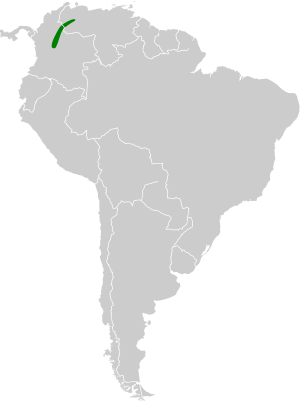Luis Manuel's tailless bat facts for kids
Quick facts for kids Luis Manuel's tailless bat |
|
|---|---|
| Conservation status | |
| Scientific classification | |
| Genus: |
Anoura
|
| Species: |
luismanueli
|
 |
|
| Distribution | |
The Luis Manuel's tailless bat (Anoura luismanueli) is a special kind of bat. It belongs to the Phyllostomidae family, which includes many types of bats found in Central and South America. This bat is called "tailless" because it has a very short tail, or sometimes no tail at all!
This unique bat is found only in certain parts of Venezuela and the eastern side of the Cordillera Oriental mountains in Colombia. When an animal is found only in one specific area, we say it is endemic to that place.
Contents
What is Luis Manuel's Tailless Bat?
Luis Manuel's tailless bat is a small to medium-sized bat. Like other bats, it has wings made of skin stretched between its long fingers and body. These bats are known for their long snouts and tongues. This helps them reach nectar deep inside flowers.
Where Does This Bat Live?
This bat lives in tropical mountain forests. It prefers areas with lots of trees and flowers. These forests provide the food and shelter the bats need to survive.
Bat Habitat in Venezuela and Colombia
The Luis Manuel's tailless bat makes its home in the high parts of the Andes mountains. These areas have a cool, moist climate. They are often covered in cloud forests, which are perfect for many unique plants and animals.
What Does This Bat Eat?
Luis Manuel's tailless bats are mostly nectivores. This means they love to drink nectar from flowers, just like hummingbirds! They also eat pollen, which gives them important nutrients. Sometimes, they might eat small insects too.
How Bats Help Plants
When these bats visit flowers to drink nectar, pollen sticks to their fur. As they fly to other flowers, they carry this pollen with them. This process is called pollination. It helps plants make seeds and grow new plants. So, these bats are very important for the health of their forest homes!
Life Cycle and Reproduction
Like other bats, Luis Manuel's tailless bats give birth to live young. A baby bat is called a pup. Mother bats usually have one pup at a time. The pups are born without fur and are completely dependent on their mothers.
Raising Bat Pups
Bat pups drink their mother's milk until they are old enough to fly and find their own food. They learn how to hunt and navigate using echolocation. Echolocation is like a natural sonar system. Bats send out sounds and listen for the echoes to create a map of their surroundings.
Why is This Bat Special?
Luis Manuel's tailless bat is special because it helps pollinate many plants in its habitat. Without bats like this, some plants might struggle to reproduce. This bat is also unique because it is only found in a small part of the world.
Conservation Status
The conservation status of Luis Manuel's tailless bat is listed as "Least Concern" (LC) by the IUCN. This means that, for now, its population is stable and it is not considered to be at high risk of extinction. However, like many animals, its habitat could be threatened by deforestation or climate change in the future.
See also
 In Spanish: Anoura luismanueli para niños
In Spanish: Anoura luismanueli para niños


